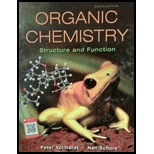
(a)
Interpretation: The structure of the enantiomer of the arabinose needs to be drawn.
Concept Introduction: Enantiomer has an opposite configuration about the chiral atom.
(b)
Interpretation: The other enantiomer needs to be drawn.
Concept Introduction: Enantiomer has just opposite configuration about the chiral atom.
(c)
Interpretation: The structure of diastereomer of arabinose needs to be determined.
Concept Introduction:Diastereomer has the same configuration but opposite configuration about chiral atom.
(d)
Interpretation: The number of other diastereomer needs to be determined.
Concept Introduction:Diastereomer has just opposite configuration about chiral atom, rest configuration will be same.
(e)
Interpretation:The rotation of the structure needs to be determined.
Concept Introduction:Rotation is defined as an angle how much the group is rotated about chiral atom of the molecule.
(f)
Interpretation: The rotation of diastereomer needs to be determined.
Concept Introduction:Diastereomer has rotation about chiral atom only.
(g)
Interpretation: The optically inactive diastereomer needs to be explained.
Concept Introduction:If a diastereomer has a plane of mirror then it is optically inactive.
Want to see the full answer?
Check out a sample textbook solution
Chapter 5 Solutions
EBK ORGANIC CHEMISTRY
- Which of the following are descriptions of possible starting material for this reaction? H ? trace acid an ester a ketone an imine an aldehyde a carboxylic acid an enamine a primary amine a secondary amine a tertiary aminearrow_forwardNonearrow_forwardWhat are the reagents needed for this and the third structure I only got the top right structure rightarrow_forward
- Please label this COZY spectraarrow_forwardPlease label this HNMRarrow_forwardConsider the following gas chromatographs of Compound A, Compound B, and a mixture of Compounds A and B. Inject A B mixture Area= 9 Area = 5 Area = 3 Area Inject . མི། Inject J2 What is the percentage of Compound B in the the mixture?arrow_forward
- Rank these according to stability. CH3 H3C CH3 1 CH3 H3C 1 most stable, 3 least stable O 1 most stable, 2 least stable 2 most stable, 1 least stable O2 most stable, 3 least stable O3 most stable, 2 least stable O3 most stable, 1 least stable CH3 2 CH3 CH3 H₂C CH3 3 CH3 CHarrow_forwardConsider this IR and NMR: INFRARED SPECTRUM TRANSMITTANCE 0.8- 0.6 0.4 0.2 3000 10 9 8 00 HSP-00-541 7 CO 6 2000 Wavenumber (cm-1) сл 5 ppm 4 M Which compound gave rise to these spectra? N 1000 1 0arrow_forwardConsider this reaction (molecular weights are under each compound): HC=CH + 2 HCI --> C2H4Cl 2 MW = 26 36.5 99 If 4.4 g of HC=CH are reacted with 110 mL of a 2.3 M HCI solution, and 6.0 g of product are actually produced, what is the percent yield?arrow_forward

 Organic ChemistryChemistryISBN:9781305580350Author:William H. Brown, Brent L. Iverson, Eric Anslyn, Christopher S. FootePublisher:Cengage Learning
Organic ChemistryChemistryISBN:9781305580350Author:William H. Brown, Brent L. Iverson, Eric Anslyn, Christopher S. FootePublisher:Cengage Learning

